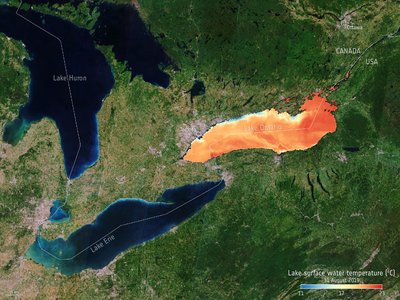2. September 2022
BAMS ‘State Of The Climate 2021’ report on global climate changes
Record high speeds in rock glaciers and record high lake temperatures amongst other impacts of climate change in 2021
A new State of the Climate report, published by the Bulletin of the American Meteorological Society, shows record high speeds in rock glaciers and record high lake temperatures amongst other impacts of climate change in 2021.
This is the 32nd edition of an annual peer-reviewed series providing a comprehensive global update on climate indicators and weather events in the previous full year.
The trends in the major climate indicators are consistent with a warming planet, but weak-to-moderate La Niña conditions in the eastern equatorial Pacific dampened temperatures temporarily at a global scale. Many of the key climate data records reported on depend on satellite missions.
Rock glaciers are debris landforms resulting from the creep of frozen ground in most mountain ranges around the world. With warming temperatures, many areas of permafrost are approaching the melting point of ice at zero degrees Celsuis, driving an acceleration in rock glacier speeds across all mountain regions. The speed responds synchronously with variations in permafrost temperature.
New satellite-derived datasets from ESA’s Permafrost CCI project help illustrate the observed increase in all rock glacier speeds in the Andes, with an acceleration since 2010. In the Alps, rock glacier velocities are now 2 to 10 times faster than in the 1980s. The ESA Permafrost CCI team also recently permafrost extent in the northern hemisphere from 2003 to 2017.
Lakes worldwide continue to feel the heat of climate change, with the highest temperatures on record in 2021, 0.6 Celsius above the 1996-2016 average. Ice cover on lakes was 19 days fewer in the 2020/21 winter season compared with 1991-2020. Lake surface temperature can be derived from satellite, giving a global representative view of the changes due to climate change. Work by Iestyn Woolway while he was an ESA research fellow working with global data from Lakes CCI project is cited in the report.

Atmospheric carbon dioxide levels have again reached record levels, with the 5th highest growth rate since the start of the instrumental record in 1958. The growth in atmospheric methane was the highest on record, and the third highest rate for nitrous oxide, both also reaching new record levels.
In addition to record and rising levels of key greenhouse gases, the report highlights that for a 10th consecutive year, global mean sea level rose to a new record high: 97mm above the 1993 average. Change in sea level is broadly consistent with the CCI global satellite altimetry record (1993-2022) that is produced operationally by Copernicus Climate Change service. The IPCC’s sixth Assessment report points to an acceleration in the rate of rise to 3.7mm/yr between 2008-2018. Loss of land ice from glaciers and ice sheets – which are under investigation within the CCI programme – are major contributors to of this rising trend.
Global surface soil moisture conditions in 2021 were wetter than usual (with respect to 1991-2020 period), based on satellite-based climate data records from ESA CCI Soil Moisture. These data, from active and passive microwave sensors from multiple satellite missions, provide gridded soil moisture on a global-scale 1978-2021.
Europe fits this pattern, aligning with the heavy rainfall and flooding in summer 2021. Particularly noteworthy for above average precipitation are Northeastern China and southern India.
Monitoring soil moisture conditions is key for our understanding of the climate system, due to its role in the energy and water fluxes at the land–atmosphere boundary. The CCI Soil moisture project has contributed to the report over the past 11 years.
More than 530 scientists in over 60 countries contributed to the report, which reflects tens of thousands of independent datasets from instruments located on land, in oceans and lakes, as well as from satellites. Several of the contributing authors to the report are supported by the CCI programme. Peer-reviewed publications and data covering ozone, ice sheets, sea ice, glaciers, snow and soil moisture CCI projects were also cited.
All datasets developed by the CCI are free and open access via the CCI Open Data Portal.
The State of the Climate in 2021 report is published as a special supplement to the Bulletin of the American Meteorological Society. The full report is openly available online.

